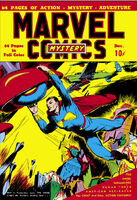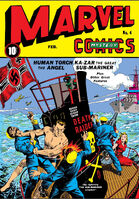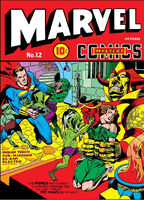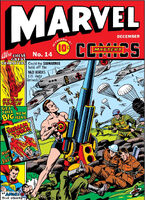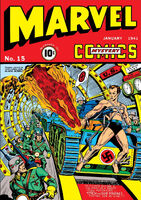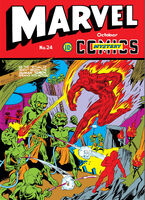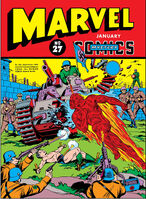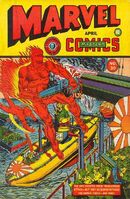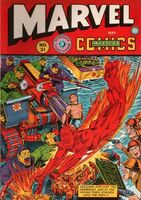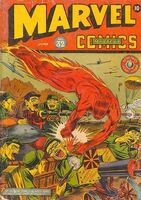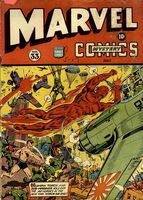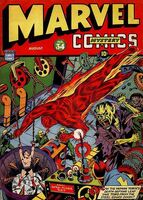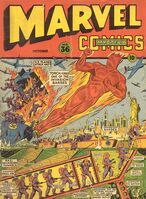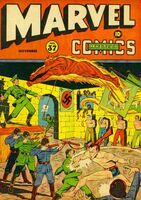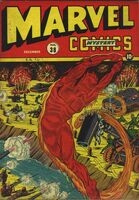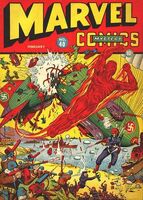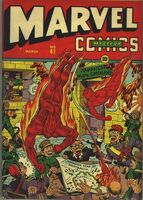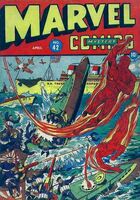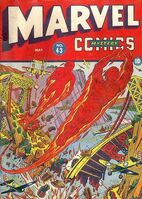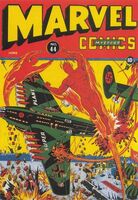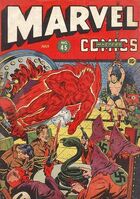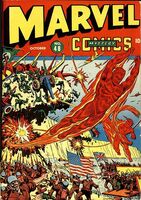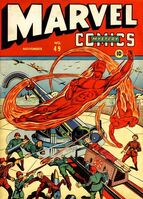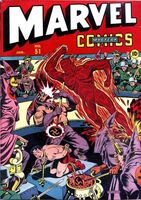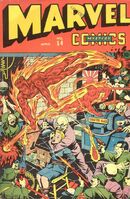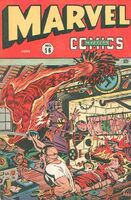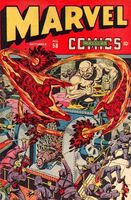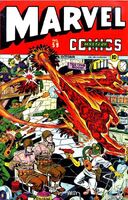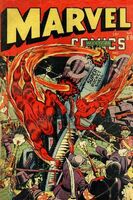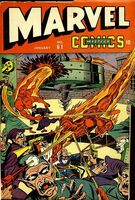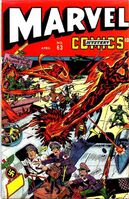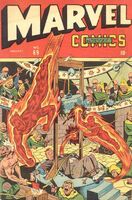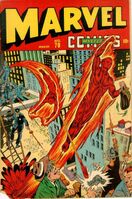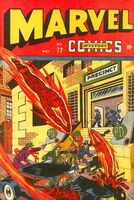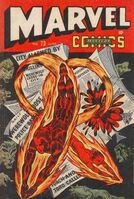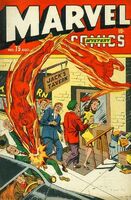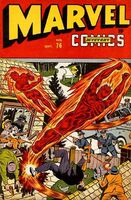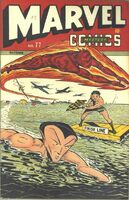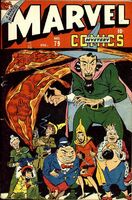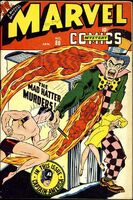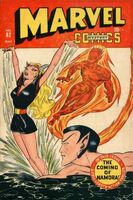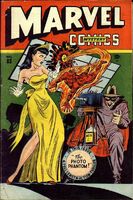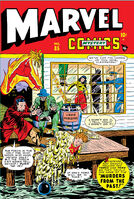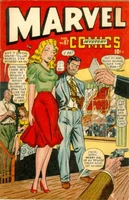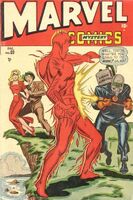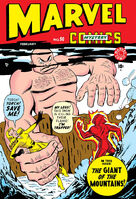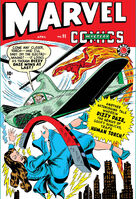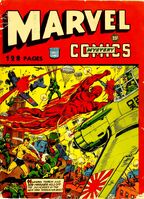| Publisher: Timely Comics Type: Ongoing Series Genre: Super Hero | Status: Finished Publication Date: December, 1939—June, 1949 |
| 92 issues • 910 images • 41 reprinted issues • 5 TPB editions | Next Volume |
Marvel Mystery Comics was the first ever comic series published by Timely Comics, the company that would later go on to become Marvel Comics Entertainment. The series first began publishing under the title Marvel Comics in October 1939, and after the first issue, the title was renamed Marvel Mystery Comics for the duration of its run.
Marvel Mystery Comics was an anthology series that introduced the first heroes of the Marvel Universe, such as the Human Torch, the Sub-Mariner, Angel, western hero Masked Raider, and a comic book adaptation by Ben Thompson of the pulp magazine Tarzan clone named Ka-Zar. Each issue also featured a text story, and early on in its run featured various one-shot stories about explorers and adventurers such as Ken Masters, American Ace and others.
During the early 1940s, the major staples of the title were the Torch, Sub-Mariner, Ka-Zar and Angel. The Angel had the longest run of any character in the series and appeared in every issue until he was removed from the title after Marvel Mystery Comics #79. Ka-Zar remained a regular character in the series until issue number 27, while the Masked Raider was phased out of the title by issue 12, and the other popular characters ran until the series ended in 1949. Issue number 4 was the introduction to the robot Electro who was a regular feature in the series until issue 19 and the private detective known as the Ferret who appeared in the series until issue 9. By 1941, the influence of World War II had an impact on comic books, with many of the characters in Marvel Mystery Comics beginning to fight Nazi spies throughout the issues running between 1941 to late 1946.
Issue number 9 also featured the first of many clashed between the Human Torch and Sub-Mariner. It was also the first time during the series' run that a story was continued in a following issue, with the Human Torch and Sub-Mariner bout lasting until Marvel Mystery Comics #11. Stories that spanned multiple issues were rare during the series' run, the longest running story being the ongoing Ka-Zar stories. Most two or more part stories were phased out by Ka-Zar's last appearance in the series and were not seen again until 1946 in Marvel Mystery Comics #49. Issue 11 saw the introduction of boy detective Terry Vance who became a regular feature in the series until issue 57. Issue number 13 saw the first appearance of the original Vision, created by Jack Kirby before he left Timely to work for DC Comics. The Vision was a regular feature in the title until issue 48. Issue Marvel Mystery Comics #18 saw the addition of the Human Torch's partner Toro to the title. Issue 21 saw the addition of the Patriot to the title, he too became a long running character in the series until issue Marvel Mystery Comics #71. However, later retcons of the history of the original Captain America would have the Patriot taking the place of Captain America during the late 1940's effectively retoconning all of Captain America's later appearances in Marvel Mystery Comics to Jeff Mace, the Patriot's alter ego. Recurring villains were a rarity in this title, with the exception of Axis foes from the war, and the frequent opposition of Namor's conquest plans early on by supporting characters Betty Dean, Luther Robinson and Lynn Harris. Recurring villains included Human Torch foe the Parrot introduced in Marvel Mystery Comics #24 and killed two issues later in issue Marvel Mystery Comics #26; and Angel villain the Python a Nazi contortionist who appeared in Sub-Mariner Comics #2, appeared to die in Marvel Mystery Comics #25 but returned to menace the Human Torch and Sub-Mariner in Human Torch #8.
With the departure of Ka-Zar from the title in issue #27, the title featured the adventures of Jimmy Jupiter a boy who would daydream about the world of Nowhere. He was featured in the title until being phased out in issue 48.
The first mentions of the attacks on Pearl Harbor in the title appeared in Marvel Mystery Comics #31, thus beginning a run of stories where many of the title's characters (most commonly the Torch and Sub-Mariner) fought the Empire of Japan. Many of these early stories featured racist depictions of Japanese characters, even having the Sub-Mariner mockingly imitate Japanese stereotypes. American shock, pain and anger over the attacks were clearly communicated through these early tales, with the heroes often killing their Japanese opponents without mercy. Treatment of Japanese characters in these stories was particularly brutal when compared to clashes with Nazi villains.
With the outbreak of World War II and the initiation of the draft, writer/artists Bill Everett and Carl Burgos went on military duty, leaving their characters the Sub-Mariner and Human Torch in the hands of other creators starting with Marvel Mystery Comics #31 and Marvel Mystery Comics #33. While the Human Torch's title was mostly the same under different writers, however it appeared his android origins were mostly forgotten. The Sub-Mariner however, underwent drastic changes in appearance (the infamous "triangle" head style that lasted until the late 1940s) and the abandonment of the entire Atlantean cast of characters, Namor spent most of the 1940s assisting surface dwellers and giving up his grudge against the surface world. The two land mark title characters of this series were brought back to "basics" upon the return of Everett and Burgos to the title when they returned from the War and resumed their jobs at Timely. Everett returned to working on Sub-Mariner in Marvel Mystery Comics #84 and Burgos resumed working on the Torch in issue 88.
The title remained mostly unchanged from issue #33 until issue number Marvel Mystery Comics #49 with the exception of a brief departure of the Patriot between issues 44 and 48. With the departure of the Vision and Jimmy Jupiter, #49 saw the advent of Miss America, the first recurring female super hero added to the title. She was a regular staple to the title until issue 85. Her first appearance was also the first time there had been a two part story featured in the title since issue #27. Issue Marvel Mystery Comics #50 saw an attempt to make Patriot supporting character Mary Morgan into the hero's sidekick. She was dubbed "Miss Patriot" in the opening splash page and given radar hearing by a Nazi spy during the story. However, the plot line was dropped the following issue and the Miss Patriot character was not seen until many decades later. The title continued unchanged until 1946, the only noteworthy work being the inclusion of artist Carmine Infantino who took up penciling for the Human Torch stories starting in Marvel Mystery Comics #65 and ending at issue 79. With the war ending in 1945, stories which featured Nazis and Imperial Japanese agents as foes were soon phased out, with the occasional "flashback" to World War II stories appearing from time to time until the summer of 1946. Most characters would more often fight mobsters, and other normal criminals rather than super-powered or costumed menaces.
Issue 75 saw the Young Allies becoming a regular feature in the title, replacing the Patriot until issue 83. Issue 76 also saw the return of serialized stories, with the start of a Miss America spy epic that ran until issue 85. The Angel was bumped from the title in issue #79 to make way for Captain America stories starting in issue Marvel Mystery Comics #80. Issue number 82 saw the first appearance of Namor supporting character Namora as well as a return to Namor's Atlantean roots. The inclusion of the Blonde Phantom to the title was in issue 84, and Miss America was phased out of the title in issue #85. Marvel Mystery Comics #86 saw the long running detective story "Let's Play Detective" (featured predominantly in Captain America Comics) appearing in the title, this issue also marked the final appearance of Bucky in Marvel Mystery Comics as his role as Captain America's partner was replaced by Golden Girl in Captain America Comics #66. Likewise with Bucky, Toro makes his final appearance as the Human Torch's partner in Marvel Mystery Comics #87 as he was replaced by Sun Girl in Human Torch #32. Issue 88 not only featured Sun Girl as the Torch's new sidekick, but she also got her own regular solo feature in the title. However, by issue number 91 the Sun Girl solo stories was replaced with a solo adventures featuring Venus.
As the 1940s came to an end, Marvel Mystery Comics underwent some massive changes. Issue 92 saw Carl Burgos returning to the Human Torch to retell the character's origin. The issue also featured a brief story featuring the Witness, as well as a Captain America story, meaning the title chopped down its features to 3 stories. The series was then renamed Marvel Tales but maintained the Marvel Mystery Comics numbering. As Marvel Tales, the title saw a departure of super heroes in favor of science fiction and horror stories which were becoming popular at the time.
"Murder at the Racetrack"
Release date: October 3, 1939
Cover date: December, 1939
"The Menace from Mars"
Release date: November 17, 1939
Cover date: January, 1940
"New York Hit by Green Flame"
Release date: December 20, 1939
Cover date: February, 1940
"The Orton Medical Mission"
Release date: January 17, 1940
Cover date: March, 1940
"The Forest Fire Felons"
Release date: February 20, 1940
Cover date: April, 1940
"The Human Torch -- Policeman"
Release date: March 20, 1940
Cover date: May, 1940
"The Human Torch and the Sub-Mariner Meet"
Release date: April 24, 1940
Cover date: June, 1940
"The Human Torch versus The Sub-Mariner: The Battle of the Comic Century!"
Release date: May 17, 1940
Cover date: July, 1940
"The Human Torch and the Sub-Mariner - The Result of the Most Famous Battle in Comic Magazines"
Release date: June 15, 1940
Cover date: August, 1940
"Plague in the Slums"
Release date: July 19, 1940
Cover date: September, 1940
"The Search For J. B."
Release date: August 16, 1940
Cover date: October, 1940
"Cut-Throat Justice"
Release date: September 17, 1940
Cover date: November, 1940
"The Cult of Fire-Men"
Release date: October 25, 1940
Cover date: December, 1940
"Search for the Fire Monsters"
Release date: November 27, 1940
Cover date: January, 1941
"Pinhead and His Underworld Army"
Release date: December 13, 1940
Cover date: February, 1941
"Fighting Side-By-Side"
Release date: January 13, 1941
Cover date: March, 1941
"The Man Who Framed the Torch"
Release date: February 13, 1941
Cover date: April, 1941
"The Hag"
Release date: March 13, 1941
Cover date: May, 1941
"The Hunt for Hawk Rivers"
Release date: April 14, 1941
Cover date: June, 1941
"The Idol of Death"
Release date: May 15, 1941
Cover date: July, 1941
"The Invasion of Alslavia"
Release date: June 12, 1941
Cover date: August, 1941
"Highway of Mystery"
Release date: July 14, 1941
Cover date: September, 1941
"Meet the Parrot"
Release date: August 18, 1941
Cover date: October, 1941
"The King Crime Syndicate"
Release date: September 18, 1941
Cover date: November, 1941
"The Parrot Strikes Back"
Release date: October 20, 1941
Cover date: December, 1941
"The Flaming Arrow Murders"
Release date: November 17, 1941
Cover date: January, 1942
"The Poison Pill Suicides"
Release date: December 16, 1941
Cover date: February, 1942
"The Moonlight Murders"
Release date: January 16, 1942
Cover date: March, 1942
"March of the Metal Mobsters"
Release date: February 18, 1942
Cover date: April, 1942
"Scuttle the Japs"
Release date: March 17, 1942
Cover date: May, 1942
"The Statues of Doom"
Release date: April 13, 1942
Cover date: June, 1942
"The Dynamite Saboteurs!"
Release date: May 8, 1942
Cover date: July, 1942
"Carl Burgos Meets the Human Torch"
Release date: June 19, 1942
Cover date: August, 1942
"Air Raid Terror"
Release date: July 15, 1942
Cover date: September, 1942
"The Blackout Blitz of J-97"
Release date: August 18, 1942
Cover date: October, 1942
"The Fingerprints of Doom!"
Release date: September 18, 1942
Cover date: November, 1942
"Crime Marches On"
Release date: October 20, 1942
Cover date: December, 1942
"Smugglers of Death"
Release date: November 20, 1942
Cover date: January, 1943
"Flaming Terror"
Release date: December 23, 1942
Cover date: February, 1943
"The Stolen Bomber"
Release date: January 25, 1943
Cover date: March, 1943
"Prescriptions For Death"
Release date: February 19, 1943
Cover date: April, 1943
"Mystery of the Air Raid Spotters"
Release date: March 22, 1943
Cover date: May, 1943
"The Phantom Strikes"
Release date: April 26, 1943
Cover date: June, 1943
"Message From a Corpse"
Release date: May 23, 1943
Cover date: July, 1943
"The Glass Tube of Death"
Release date: June 20, 1943
Cover date: August, 1943
"Underground Demons"
Release date: July 31, 1943
Cover date: September, 1943
"Horror of the Masked Fiend"
Release date: August 25, 1943
Cover date: October, 1943
"Flight of the Deadly Boomerang"
Release date: September 26, 1943
Cover date: November, 1943
"Battling the Nazi Vultures"
Release date: October 26, 1943
Cover date: December, 1943
"Torch and Toro Unmask the Masquerading Mister Grim"
Release date: November 21, 1943
Cover date: January, 1944
"Tyrants Must Die"
Release date: December 19, 1943
Cover date: February, 1944
"Master Plan For Destruction"
Release date: January 24, 1944
Cover date: March, 1944
"Human Torch"
Release date: February 17, 1944
Cover date: April, 1944
"The Terrorists of Time"
Release date: March 19, 1944
Cover date: May, 1944
"Berlin's Master Spy"
Release date: April 21, 1944
Cover date: June, 1944
"Death Rides the Rails!"
Release date: May 18, 1944
Cover date: July, 1944
"Versus the Nazi Super Spy"
Release date: July 13, 1944
Cover date: September, 1944
"Madman of Terror Mountain"
Release date: August 14, 1944
Cover date: October, 1944
"Death Spins the Wheel"
Release date: October 16, 1944
Cover date: December, 1944
"The Secret of the Masked Horror"
Release date: November 15, 1944
Cover date: January, 1945
"Dolls of Death"
Release date: January 14, 1945
Cover date: March, 1945
"Killers Inc."
Release date: February 22, 1945
Cover date: April, 1945
"The Bogus Bride Groom"
Release date: March 31, 1945
Cover date: June, 1945
"Worthless Beads"
Release date: May 9, 1945
Cover date: July, 1945
"Devil's Mutineers"
Release date: July 17, 1945
Cover date: September, 1945
"Death Bird of Thunder Mountain"
Release date: August 16, 1945
Cover date: November, 1945
"The Wolf of Gotham"
Release date: November 22, 1945
Cover date: Jan, 1946
"The Laughing Sneak Thief"
Release date: December 19, 1945
Cover date: February, 1946
"The Case of the Frightened Felon"
Release date: January 14, 1946
Cover date: March, 1946
"Formula for Murder"
Release date: February 18, 1946
Cover date: April, 1946
"Conquest of Death"
Release date: March 14, 1946
Cover date: May, 1946
"Killer Boss of Westport"
Release date: April 15, 1946
Cover date: June, 1946
"Escape From Doom"
Release date: May 15, 1946
Cover date: July, 1946
"The Ventriloquist's Vengeance"
Release date: June 18, 1946
Cover date: August, 1946
"The Queen of Crime"
Release date: July 16, 1946
Cover date: September, 1946
"The Golden Calf Murders"
Release date: August 16, 1946
Cover date: October, 1946
"Three Thousand Years Dead"
Release date: September 12, 1946
Cover date: November, 1946
"The Mother Goose Robberies"
Release date: October 13, 1946
Cover date: December, 1946
"Murder Melodies"
Release date: November 17, 1946
Cover date: January, 1947
"The Crimson Terror"
Release date: January 21, 1947
Cover date: March, 1947
"The Laughing Killer"
Release date: April 5, 1947
Cover date: May, 1947
"The Photo Phantom"
Release date: June 7, 1947
Cover date: July, 1947
"Terror from Bagdad"
Release date: July 28, 1947
Cover date: October, 1947
"Murders from the Past"
Release date: October 28, 1947
Cover date: February, 1948
"Carnival of Crime"
Release date: February 6, 1948
Cover date: June, 1948
"Master of Murder"
Release date: May 3, 1948
Cover date: August, 1948
"The Lethal Lollipops"
Release date: June 20, 1948
Cover date: October, 1948
"The Case of the Granite Bandit"
Release date: August 18, 1948
Cover date: December, 1948
"The Giant of the Alps"
Release date: October 20, 1948
Cover date: February, 1949
"Trapped By Dizzy Daze"
Release date: December 16, 1948
Cover date: April, 1949
"The Birth of the Torch"
Release date: February 16, 1949
Cover date: June, 1949
Release date: June 15, 1943
Cover date: 1943
Notes
Milestone Issues[]
- Marvel Comics #1 - The first appearance of the Human Torch, Sub-Mariner (and supporting cast), Angel, Masked Raider, and Ka-Zar
- Marvel Mystery Comics #4 - First appearance of the robot Electro and private detective the Ferret.
- Marvel Mystery Comics #9 - The first battle between the Human Torch and Sub-Mariner and the last Golden Age Ferret story.
- Marvel Mystery Comics #11 - First appearance of Terry Vance and his supporting cast.
- Marvel Mystery Comics #12 - The last Golden Age Masked Raider story.
- Marvel Mystery Comics #13 - First appearance of the Vision.
- Marvel Mystery Comics #18 - The first appearance of Toro in the pages of Marvel Mystery Comics (His first appearance in a Timely Publication was Human Torch #2.
- Marvel Mystery Comics #19 - The last Golden Age Electro story.
- Marvel Mystery Comics #21 - The first appearance of the Patriot and his supporting cast in Marvel Mystery Comics (The character first appeared in Human Torch #3).
- Marvel Mystery Comics #27 - The last Golden Age Ka-Zar story.
- Marvel Mystery Comics #28 - First appearance of Jimmy Jupiter.
- Marvel Mystery Comics #31 - The last Sub-Mariner comic written and drawn by Bill Everett until issue 84.
- Marvel Mystery Comics #33 - The last Human Torch comic written and drawn by Carl Burgos until issue 88.
- Marvel Mystery Comics #48 - Last Golden Age Vision story in Marvel Mystery Comics (His final Golden Age appearance was in Kid Komics #3). This issue also marks the final Golden Age Jimmy Jupiter story as well.
- Marvel Mystery Comics #49 - First appearance of Miss America.
- Marvel Mystery Comics #50 - First "appearance" of character Mary Morgan as Miss Patriot.
- Marvel Mystery Comics #57 - Last Golden Age Terry Vance story in Marvel Mystery Comics (His final Golden Age appearance was in Mystic Comics (Vol. 2) #2).
- Marvel Mystery Comics #65 - First Human Torch story drawn by Carmine Infantino for this title.
- Marvel Mystery Comics #74 - The last Golden Age appearance of the Patriot in this title.
- Marvel Mystery Comics #75 - First Young Allies story to appear in Marvel Mystery Comics.
- Marvel Mystery Comics #79 - Last issue of the Human Torch drawn by Carmine Infantino for this title. Also the last Golden Age Angel story.
- Marvel Mystery Comics #80 - First Captain America story to appear in Marvel Mystery Comics.
- Marvel Mystery Comics #82 - First appearance of Namora.
- Marvel Mystery Comics #83 - The last Golden Age appearance of the Young Allies.
- Marvel Mystery Comics #84 - First Blonde Phantom story featured in Marvel Mystery Comics.
- Marvel Mystery Comics #85 - Last Golden Age appearance of Miss America.
- Marvel Mystery Comics #86 - Last appearance of Bucky in Marvel Mystery Comics.
- Marvel Mystery Comics #87 - First Golden Girl appearance in a Marvel Mystery Comics story, last appearance of Toro in a Marvel Mystery Comics story.
- Marvel Mystery Comics #88 - First Sun Girl appearance in a Marvel Mystery Comics story.
- Marvel Mystery Comics #91 - Sun Girl solo stories replaced with Venus stories, her only appearance in Marvel Mystery Comics. Also the last Marvel Mystery Comics stories featuring Sun Girl, Blonde Phantom,
Reprints and Collections[]
- There have been six volumes of Marvel Masterworks devoted to Marvel Mystery Comics publishing issue #1-24
- Marvel released an Omnibus edition of Marvel Mystery Comics featuring the first 12 issues of the series.
- In 2009 to celebrate 70 years of Publication Marvel reprinted Marvel Comics #1 with modern coloring techniques and released Marvel Mystery Comics 70th Anniversary Special #1 which featured a new story featuring many of the books original title characters and reprinting some classic tales.
Title Retcons[]
The most massive retcon done to the title pertains to the history of Captain America and his partner Bucky. The character appeared in many Timely and Atlas era publications until the 1950s. When the character was revived in Avengers #4 by Stan Lee and Jack Kirby they retconned the characters' history so that the original Captain America and Bucky (Steve Rogers and James Barnes) were seemingly killed near the end of the war. Both were placed into suspended animation and later revived in the modern age. The reintroduction of 1940s characters and continuity into Marvel's line of books in the 1970s led to a retcon created to explain Captain America and Bucky's appearances post 1943. The solution was having other characters taking on the role as revealed in What If? #4 and Captain America #205. As such, all the appearances of Captain America and Bucky in the title can be attributed to Jeff Mace (formally the Patriot) and Fred Davis Jr.
The other retcon is revealed in Young Allies Comics 70th Anniversary Special #1 which reveals many of the Young Allies early adventures were really comic books commissioned by the United States Army as wartime propaganda. All the Young Allies adventures featured in this title are considered to be overly sensationalized works of fiction based on the real life adventures of the Young Allies.
Character Legacies[]
The most lasting characters that were introduced to the title were the Sub-Mariner and the Human Torch, who were phased out in the late 1940s when super hero comics were no longer popular. They enjoyed a brief revival in the mid-1950s as well under Timely's successor Atlas Comics before losing popularity once more. When Atlas became Marvel Comics and super heroes were becoming popular again, many Golden Age characters were revived. The Human Torch concept was reenvisioned and a new Human Torch was created for the 1961's Fantastic Four #1, however, the original Human Torch was revived in Fantastic Four Annual #4. The Sub-Mariner was brought back in Fantastic Four #4. Both characters have made regular appearances in the modern era, the Sub-Mariner being the one with the lasting publication history. The Torch was often killed off and resurrected many times over the years. Toro was revived during this time and killed battling the Sub-Mariner in Sub-Mariner #14, he was later resurrected at the conclusion of 2009's Avengers / Invaders cross-over.
With a resurgence in popularity of wartime super heroes, Marvel published the Invaders #1 and other similar series bringing back characters such as Miss America, and the Patriot. The Blonde Phantom, having retired from super heroing also had a brief revival in the pages of the Sensational She-Hulk from issue 2 through 53. Most recently the character was featured in 2011's Avengers 1959.
The Angel's character was revived in the late 1980s as an old man and has made sparse appearances in the modern era of publication, reappearing first in U.S.Agent #4. There also featured a retcon that his brother Simon also took on the mantle of the Angel.
The majority of other characters saw modest mentions and revivals during the modern age of publication. However, when Marvel celebrating its 70th Anniversary, a number of the long forgotten characters had new life breathed into them (likely to keep the copyrights on the characters active as well). The series such as the Marvels Project and the Twelve was the revival of characters such as the Angel, Electro, the Ferret, and many other characters who appeared in Marvel Mystery Comics, allowing modern writers to tie in the characters histories and activities together. Marvel also published a series of 70th Anniversary specials showcasing Timely Comics original titles broadening character interactions. Also celebrating Captain America's long history was a series title Captain America: Patriot that fleshed out the Patriot becoming Captain America's second replacement from 1946-1950. It also saw the revival of Mary Morgan becoming the costumed hero Miss Patriot and retconned a history of the character during the Patriot's career as Captain America. Jimmy Jupiter was briefly revived and retconned into the history of Captain America starting in Captain America (Vol. 6) #1, where he was used as a weapon in the War, but fell into a coma until the modern age. The character was killed off in Captain America (Vol. 6) #5. Lastly, a number of Marvel Mystery Comics characters were given profiles in the Marvel Mystery Handbook 70th Anniversary Special #1 as well as the Official Handbook of the Marvel Universe A to Z #14.

